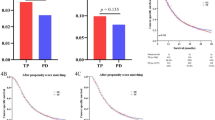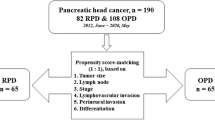Abstract
Background
The safety and feasibility of completion total pancreatectomy (TP) for remnant pancreatic neoplasms remain controversial and are rarely compared with that of initial TP. Thus, we aimed to compare the safety of these two procedures inducing a pancreatic state.
Methods
Patients who underwent TP for pancreatic neoplasms between 2006 and 2018 at our institution were included in this study. Tumor pathologies were classified into three subgroups according to survival curves. We used 1:1 propensity score matching (PSM) to analyze age, sex, Charlson Comorbidity Index, and tumor stage. Finally, we analyzed the primary outcome Clavien–Dindo classification (CDC) grade, risks of other safety-related outcomes, and the survival rate of patients with invasive cancer.
Results
Of 54 patients, 16 underwent completion TP (29.6%) and 38 (70.4%) underwent initial TP. Before PSM analysis, age and Charlson Comorbidity Index were significantly higher, and T category and stage were significantly lower for the completion TP group. Upon PSM analysis, these two groups were equivalent in CDC grade [initial TP vs. completion TP: 71.4% (10/14) vs. 78.6% (11/14); p = 0.678] and other safety-related outcomes. Additionally, while the overall survival and recurrence-free survival of patients with invasive cancer were not significantly different between these two groups, the T category and stage tended to be remarkably severe in the initial TP group.
Conclusions
PSM analysis for prognostic factors showed that completion TP and initial TP have similar safety-related outcomes that can be used as a decision-making reference in the surgery of pancreatic tumors.


Similar content being viewed by others
References
Riall TS, Lillemoe KD. Underutilization of surgical resection in patients with localized pancreatic cancer. Ann Surg. 2007;246:181–2.
Roberts KJ. Improving outcomes in patients with resectable pancreatic cancer. Br J Surg. 2017;104:1421–3.
Hartwig W, Werner J, Jäger D, Debus J, Büchler MW. Improvement of surgical results for pancreatic cancer. Lancet Oncol. 2013;14:e476–85.
Billings BJ, Christein JD, Harmsen WS, et al. Quality-of-life after total pancreatectomy: is it really that bad on long-term follow-up? J Gastrointest Surg. 2005;9:1059–66.
Epelboym I, Winner M, DiNorcia J, et al. Quality of life in patients after total pancreatectomy is comparable with quality of life in patients who undergo a partial pancreatic resection. J Surg Res. 2014;187:189–96.
Pulvirenti A, Pea A, Rezaee N, et al. Perioperative outcomes and long-term quality of life after total pancreatectomy. Br J Surg. 2019;106:1819–28.
Scholten L, Latenstein AEJ, van Eijck C, et al. Outcome and long-term quality of life after total pancreatectomy (PANORAMA): a nationwide cohort study. Surgery. 2019;166:1017–26.
Scholten L, Stoop TF, Del Chiaro M, et al. Systematic review of functional outcome and quality of life after total pancreatectomy. Br J Surg. 2019;106:1735–46.
Watanabe Y, Ohtsuka T, Matsunaga T, et al. Long-term outcomes after total pancreatectomy: special reference to survivors’ living conditions and quality of life. World J Surg. 2015;39:1231–9.
Wu W, Dodson R, Makary MA, et al. A contemporary evaluation of the cause of death and long-term quality of life after total pancreatectomy. World J Surg. 2016;40:2513–8.
Almond M, Roberts KJ, Hodson J, et al. Changing indications for a total pancreatectomy: perspectives over a quarter of a century. HPB (Oxford). 2015;17:416–21.
Groot VP, Gemenetzis G, Blair AB, et al. Defining and predicting early recurrence in 957 patients with resected pancreatic ductal adenocarcinoma. Ann Surg. 2019;269:1154–62.
Mandai K, Uno K, Yasuda K. Pancreatic ductal adenocarcinoma concomitant with intraductal papillary mucinous neoplasm: a report of 8 cases. Clin J Gastroenterol. 2013;6:248–54.
Ohtsuka T, Kono H, Tanabe R, et al. Follow-up study after resection of intraductal papillary mucinous neoplasm of the pancreas; special references to the multifocal lesions and development of ductal carcinoma in the remnant pancreas. Am J Surg. 2012;204:44–8.
Takigawa Y, Kitago M, Matsui J. Independent predictors of secondary invasive pancreatic remnant tumors after initial resection of an intraductal papillary mucinous neoplasm: a nationwide large-scale survey in Japan. Surg Today. 2020;50:1672–80.
Tanno S, Nakano Y, Sugiyama Y, et al. Incidence of synchronous and metachronous pancreatic carcinoma in 168 patients with branch duct intraductal papillary mucinous neoplasm. Pancreatology. 2010;10:173–8.
Winner M, Epelboym I, Remotti H, et al. Predictors of recurrence in intraductal papillary mucinous neoplasm: experience with 183 pancreatic resections. J Gastrointest Surg. 2013;17:1618–26.
Matsuda R, Miyasaka Y, Ohishi Y, et al. Concomitant intraductal papillary mucinous neoplasm in pancreatic ductal adenocarcinoma is an independent predictive factor for the occurrence of new cancer in the remnant pancreas. Ann Surg. 2020;271:941–8.
Kleeff J, Reiser C, Hinz U, et al. Surgery for recurrent pancreatic ductal adenocarcinoma. Ann Surg. 2007;245:566–72.
Miura F, Takada T, Amano H, et al. Repeated pancreatectomy after pancreatoduodenectomy. J Gastrointest Surg. 2007;11:179–86.
Thomas RM, Truty MJ, Nogueras-Gonzalez GM, et al. Selective reoperation for locally recurrent or metastatic pancreatic ductal adenocarcinoma following primary pancreatic resection. J Gastrointest Surg. 2012;16:1696–704.
Levi Sandri GB, Colasanti M, Aldrighetti L, et al. Is minimally invasive liver surgery a reasonable option in recurrent HCC? A snapshot from the I Go MILS registry. Updates Surg. 2022;74:87–96.
Miyazaki M, Yoshitomi H, Shimizu H, et al. Repeat pancreatectomy for pancreatic ductal cancer recurrence in the remnant pancreas after initial pancreatectomy: is it worthwhile? Surgery. 2014;155:58–66.
St-Louis E, Gowing SD, Mossallanejad P, Leimanis ML, Mueller C, Ferri LE. Outcomes after completion total gastrectomy for gastric remnant cancer: experience from a Canadian tertiary centre. Can J Surg. 2018;61:270–7.
Zhou Y, Song A, Wu L, Si X, Li Y. Second pancreatectomy for recurrent pancreatic ductal adenocarcinoma in the remnant pancreas: a pooled analysis. Pancreatology. 2016;16:1124–8.
Chun YS, Pawlik TM, Vauthey JN. 8th Edition of the AJCC cancer staging manual: pancreas and hepatobiliary cancers. Ann Surg Oncol. 2018;25:845–7.
Charlson ME, Pompei P, Ales KL, MacKenzie CR. A new method of classifying prognostic comorbidity in longitudinal studies: development and validation. J Chronic Dis. 1987;40:373–83.
Dindo D, Demartines N, Clavien PA. Classification of surgical complications: a new proposal with evaluation in a cohort of 6336 patients and results of a survey. Ann Surg. 2004;240:205–13.
Chung CS, Lo WC, Lee YC, Wu MS, Wang HP, Liao LJ. Image-enhanced endoscopy for detection of second primary neoplasm in patients with esophageal and head and neck cancer: a systematic review and meta-analysis. Head Neck. 2016;38(Suppl 1):E2343-2349.
Shimada H, Fukagawa T, Haga Y, Oba K. Does remnant gastric cancer really differ from primary gastric cancer? A systematic review of the literature by the task force of Japanese gastric cancer association. Gastric Cancer. 2016;19:339–49.
Buchler MW, Wagner M, Schmied BM, Uhl W, Friess H, Z’Graggen K. Changes in morbidity after pancreatic resection: toward the end of completion pancreatectomy. Arch Surg. 2003;138:1310–4.
Mayeux SE, Kwon W, Rosario VL, et al. Long-term health after pancreatic surgery: the view from 9.5 years. HPB (Oxford). 2021;23:595–600.
Kawaida H, Kono H, Hosomura N, et al. Surgical techniques and postoperative management to prevent postoperative pancreatic fistula after pancreatic surgery. World J Gastroenterol. 2019;25:3722–37.
Balzano G, Maffi P, Nano R, et al. Autologous islet transplantation in patients requiring pancreatectomy: a broader spectrum of indications beyond chronic pancreatitis. Am J Transplant. 2016;16:1812–26.
Datta J, Lewis RS Jr, Strasberg SM, et al. Quantifying the burden of complications following total pancreatectomy using the postoperative morbidity index: a multi-institutional perspective. J Gastrointest Surg. 2015;19:506–15.
Hartwig W, Gluth A, Hinz U, et al. Total pancreatectomy for primary pancreatic neoplasms: renaissance of an unpopular operation. Ann Surg. 2015;261:537–46.
Hempel S, Oehme F, Tahirukaj E, et al. More is more? Total pancreatectomy for periampullary cancer as an alternative in patients with high-risk pancreatic anastomosis: a propensity score-matched analysis. Ann Surg Oncol. 2021;28:8309–17.
Johnston PC, Lin YK, Walsh RM, et al. Factors associated with islet yield and insulin independence after total pancreatectomy and islet cell autotransplantation in patients with chronic pancreatitis utilizing off-site islet isolation: Cleveland Clinic experience. J Clin Endocrinol Metab. 2015;100:1765–70.
Nikfarjam M, Low N, Weinberg L, Chia PH, He H, Christophi C. Total pancreatectomy for the treatment of pancreatic neoplasms. ANZ J Surg. 2014;84:823–6.
Pulvirenti A, Marchegiani G, Pea A, et al. Clinical implications of the 2016 international study group on pancreatic surgery definition and grading of postoperative pancreatic fistula on 775 consecutive pancreatic resections. Ann Surg. 2018;268:1069–75.
Luttges J. What’s new? The 2010 WHO classification for tumours of the pancreas [in German]. Pathologe. 2011;32(Suppl 2):332–6.
Inzani F, Petrone G, Rindi G. The new world health organization classification for pancreatic neuroendocrine neoplasia. Endocrinol Metab Clin North Am. 2018;47:463–70.
Cong L, Liu Q, Zhang R, et al. Tumor size classification of the 8(th) edition of TNM staging system is superior to that of the 7(th) edition in predicting the survival outcome of pancreatic cancer patients after radical resection and adjuvant chemotherapy. Sci Rep. 2018;8:10383.
Acknowledgment
The authors thank Yukiko Shimizu and Yu Aimi for data management, and Editage (www.editage.com) for English language editing.
Funding
This study was supported by a Grant from the Japan Society for the Promotion of Science (JSPS) [KAKENHI 21K08732] awarded to TM.
Author information
Authors and Affiliations
Contributions
Conceptualization: EK, AM, KT, and TM. Methodology: EK and TM. Investigation: EK and TM. First draft—writing: EK, TM, KN, TA, YK, AY, TI, AM, KT, and EH. Funding acquisition: TM. Resources: TM and EH. Supervision: TM, AM, KT, SU, and EH.
Corresponding author
Ethics declarations
Disclosures
Eisho Kanemitsu, Toshihiko Masui, Kazuyuki Nagai, Takayuki Anazawa, Yosuke Kasai, Akitada Yogo, Tatsuo Ito, Akira Mori, Kyoichi Takaori, Shinji Uemoto, and Etsuro Hatano declare they have no potential conflicts of interest to disclose.
Additional information
Publisher's Note
Springer Nature remains neutral with regard to jurisdictional claims in published maps and institutional affiliations.
Supplementary Information
Below is the link to the electronic supplementary material.
Rights and permissions
Springer Nature or its licensor (e.g. a society or other partner) holds exclusive rights to this article under a publishing agreement with the author(s) or other rightsholder(s); author self-archiving of the accepted manuscript version of this article is solely governed by the terms of such publishing agreement and applicable law.
About this article
Cite this article
Kanemitsu, E., Masui, T., Nagai, K. et al. Propensity Score Matching Analysis of the Safety of Completion Total Pancreatectomy for Remnant Pancreatic Tumors Versus that of Initial Total Pancreatectomy for Primary Pancreatic Tumors. Ann Surg Oncol 30, 4392–4406 (2023). https://doi.org/10.1245/s10434-023-13309-6
Received:
Accepted:
Published:
Issue Date:
DOI: https://doi.org/10.1245/s10434-023-13309-6




